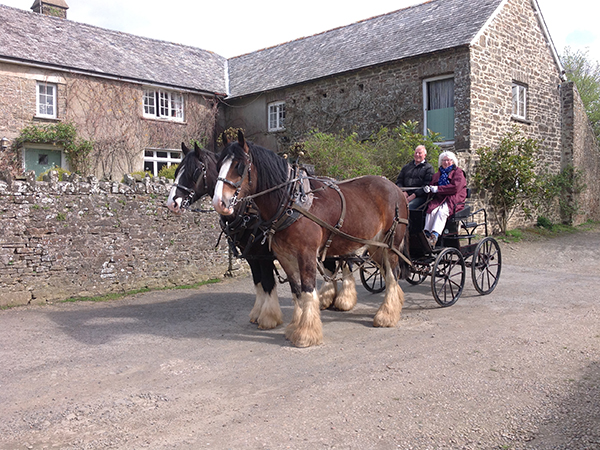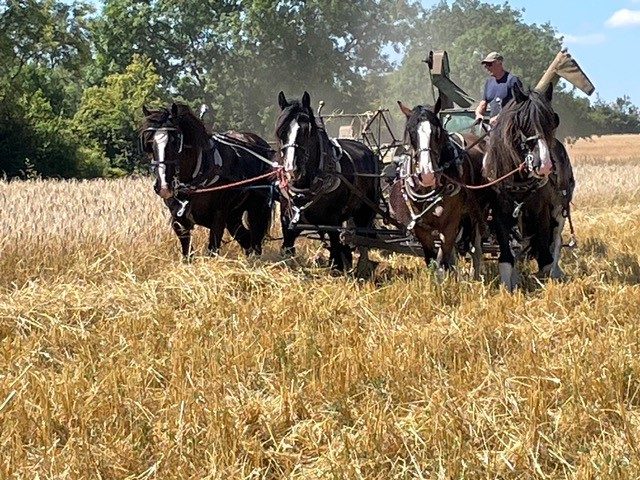
By Jonathan Waterer, who, together with his wife, Fiona, farms with horses in North Devon
As a boy of 11, I was fascinated by the harness hanging in the harness room on my family farm just outside Reading in Berkshire.
I rode a pony and loved horses. Those early years set me on a path to working on a ranch in Southern Alberta, Canada. Much of the work was still carried out on the ranch by Percherons. I learnt to be a cowboy, including breaking in Percherons, Appaloosas and Quarter Horses.
On returning to England in 1982, I settled in the South West, on Exmoor. I ran a small farm and rented more ground to accommodate 260 ewes and 40 suckler cows.
I cut grass for hay with sickle bar mowers with pairs of horses. I cut oats with a binder, hauling the sheaves into the barn with the horses. The sheaves were then fed to the cows and horses in winter.
I got married to Fiona in 1988 and in 1997 we and our young son and daughter moved to Chittlehampton to Higher Biddacott Farm, a holding of around 90 acres.
Here we started up a B&B business – nowadays we can take up to 12 people. We decided to derive our living primarily based on the horses.
We take people on driving courses teaching everything from road driving with horses, to ploughing, harrowing, rolling and forestry work.
My fundamental living is training horses of all types to both ride and drive. As I have got older there is more emphasis on the driving side.
By the time we came to Chittlehampton I was spending up to three months a year extracting timber from steep slopes, wet ground and areas with difficult access except by horse. This is an activity that is well suited to horses. Even today, if the wood is of a smallish acreage and very steep, the horse is able to pull the timber down the hillside and can be turned sharply to avoid stumps and standing trees. The alternative might be a winch tractor and two men. It is laborious, repositioning a winch tractor and cable to take the pull into a different angle to avoid stumps, thus making the horses more efficient.
I remember astounding two fellows cutting for me. I was extracting oak nearby us in Devon. Each trunk was around ¾ to 1 cubic metres weight. They were amazed at how the horse would turn sharp this way and another, to avoid all the obstacles. By the end of the first day, they reckoned 28 tons of oak had been extracted to the track below.
Besides timber work, I used the horses for some of the ploughing on the not so steep slopes. We grew 20 acres of wheat to produce thatching reed. We would use the horses for all the work. The ground would be worked down, drilled, rolled and the corn cut with a binder. Sheaves would be hauled using pairs of horses on the wagons and ricked in the field. The crop would be combed in October. We did this successfully for several years.
Over the years our horses have appeared in several films. I have spent time abroad in such far-flung places as southern Turkey training horses to pull Assyrian chariots, and spending time in Israel breaking in all sorts of horses to ride and drive. Closer to home, I have trained and supplied horses to Jersey and Guernsey.
I spent time in southwest France breaking in six Percherons to drive to be used for all tasks including tillage for wheat. It was there I got a taste for growing ancient wheat for breadmaking.
I have always looked toward the Amish in North America for harness and machinery. I was the first person to use Canadian harness in England over 40 years ago. It is far superior to our English harness in its design. The traces are leather or webbing. The collars are light and have a pad inside the collar that is removable. We change the pads every year. This design almost eliminates collar sores that we used to see with the traditional English collar.
Years ago, I started importing North American machinery from the Amish. I bought in manure spreaders, forecarts, hoes, ploughs and mowers.
If you are serious about using horses on the land you have to have multiple hitches of horses for many jobs. The work needs to be completed as efficiently as possible within the limitations of using horses as opposed to tractors.
My main tool is the motorised forecart. This machine has a pair of wheels, an air cooled 47HP diesel (or used cooking oil!) engine with PTO (Power Take Off) and spool valves. This enables me to use a Class 8.5 feet triple drum mower. I can cut five acres in three hours on our slopes. I put a conventional baler and Cooks 6 sledge behind it on to the forecart. A 6-star hay turner is also used behind it and an Activ trailed combine runs behind it also.
We put four horses abreast on the front of the forecart without engine to pull a New holland 12’ rake with an off-set pole for three horses for rolling up the hay.
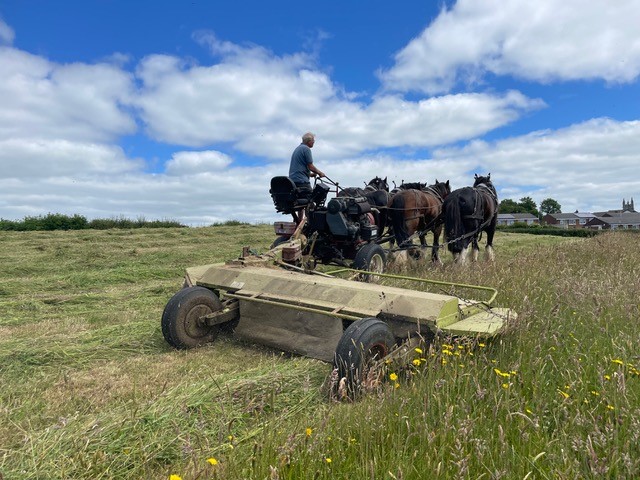
I will plough the flatter areas with an American Sulky ride-on plough. A tractor plough is used for the steeper ones.
After that, we use a culti-mulcher one-pass machine made by the Amish. It is very heavy with tines, packers and rollers. We use six horses abreast on it and in one pass you have a seed bed.
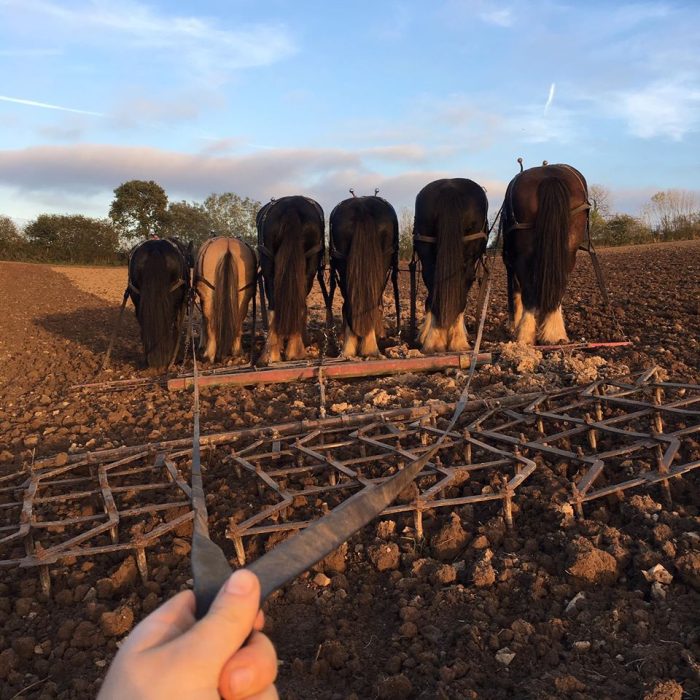
I still drill the grain with a locally made corn till. I drill roughly just over an acre an hour.
The 1965 Swedish Activ combine with a four abreast on the front of the forecart harvests the corn.
We are registered organic with the Soil Association and send our grain up to Shipton Mill near Tetbury, Glos to be stone ground. The flour is re-bagged to the 1kg bags for sale in Devon and beyond.
We train all our horses as 3-year-olds. There is nothing better to get a horse used to all noises and sounds as using them. The more work they do both on and off the farm, the more reliable they become.
The horses are like police horses by the time they go on the motorised forecart. They gain confidence from the other horses.
I am passionate about using the horses for the farm work and the weddings and funerals that we do off the farm for extra income.
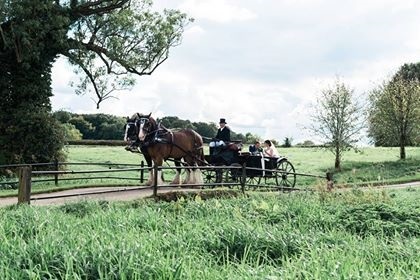
To use horses in this day and age you have to be totally dedicated and really enjoy what you do. I think nothing of going and hitching up four or six horses to do a job. It is surprising how little time it takes to do this with the harness hanging behind the horses’ tie stalls.
If you are on a small flat acreage, say a mixed farm, you could use entirely horses, no tractor.
Because our farm is so steep in places, I do not hesitate to use a tractor for cutting, turning and baling. It is impossible to do the work on such slopes using horses. The difference in draught for the horses is immense compared to working on flat ground.
If you are organic, as we are, hoeing is a great job to be done by horses. I worked out some years ago that if I hoed with a pair of horses on a two-row straddle hoe twice in the season, it was the same price as spraying for weed once.
The beauty of using horsepower on the farm is that you have so little compaction of the soil. The added benefit is that horses can replicate themselves when you need more!
The modern Shire has changed over the last 30 years. It has been bred for showing with a great emphasis in use for riding. It has lost its bone, its girth; it is taller and rather weak in its stature for work. Cow hocks seem to be the fashion. They are weak in construction for hard work. Our stallion has more bone, is smaller at 17.1 hands high, has good hocks and moves straight in his action. There are other breeds suitable for work on the farm, like the Percheron. Any good heavy horse or cob could be suitable too.
We keep five geldings and one stallion. We put our stallion on to other people’s mares and hope that we might be able to purchase back some offspring to give us our horses. Our stallion also works and is particularly even tempered with the geldings.
If you only work with the horse on the land, you have no need to shoe them. To maximise our income with the horses, we need to shoe them in order to work on the roads doing wagon rides, weddings, funerals, and training the young horses that come to be broken in.
Working with horses is extremely rewarding. You have to work out the most efficient way to get the job done in order to look after your horses. To be out in the field working with one’s horses for the day is great for the soul and body. There is nothing like horses working well to uplift the spirit.
Higher Biddacott Farm can be found on Instagram and Facebook under waterersworkinghorses. Our website is www.heavy-horses.net
